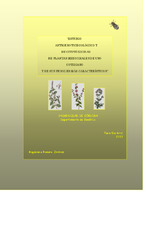Estudio antigenotoxicológico y de citotoxicidad de plantas medicinales de uso cotidiano y de sus fenoles más caracterísiticos
Autor
Romero-Jiménez, M.
Director/es
Alonso Moraga, ÁngelesMuñoz Serrano, Andrés
Editor
Universidad de Córdoba, Servicio de PublicacionesFecha
2013Materia
Plantas medicinalesGenotoxicidad
Bioactividad
Citotoxicidad
Fenoles
METS:
Mostrar el registro METSPREMIS:
Mostrar el registro PREMISMetadatos
Mostrar el registro completo del ítemResumen
Para dar respuesta al creciente interés de los consumidores sobre los efectos
beneficiosos en su salud de preparados herbales que se suelen tomar sin prescripción médica,
hemos seleccionado un grupo de plantas medicinales de uso cotidiano y fenoles contenidos en
ellas para estudiar ciertos indicadores de su posible bioactividad.
Las plantas seleccionadas ha sido de tres tipos: antiinflamatorias (Matricaria chamomilla
y Uncaria tomentosa), digestivas (Mentha piperita y Mentha pulegium) y sedantes (Tilia
cordata y Valeriana officinalis); y los fenoles contenidos en ellas: Bisabolol, Apigenina, Ácido
Protocatecuico, Mentol, Pulegona, Quercitina, Limoneno y Ácido Valerénico. Los marcadores de
bioactividad seleccionados han sido: (i) toxicidad (ensayada en el modelo eucariota Drosophila
melanogaster), (ii) genotoxicidad o seguridad genómica (ensayada en el modelo in vivo de
Mutaciones y Recombinaciones Somáticas de D. melanogaster, S.M.A.R.T.), (iii)
antigenotoxicidad o protección frente al daño genético causado por agentes oxidantes
(ensayada en el modelo in vivo de Mutaciones y Recombinaciones Somáticas de D.
melanogaster) y (iv) citotoxicidad o potencial quimiopreventivo (ensayada en el modelo de
inhibición del crecimiento tumoral in vitro de células HL60 de leucemia humana).
Todas las plantas y moléculas ensayadas han resultado tóxicas para D. melanogaster,
aunque a distintas intensidades, que son en orden creciente: V. officinalis, Ác. Valerénico,
Bisabolol, Limoneno, Quercitina, DHBA, Mentol, T. cordata, Pulegona, M. chamomilla,
Apigenina, U. tomentosa, M. pulegium, y M. piperita. Destacamos en general, las plantas
sedantes Tila y Valeriana así como sus componentes estudiados, los menos tóxicos y las
digestivas Mentas, las más tóxicas.
Ninguna planta ni molécula ha resultado genotóxica en el ensayo de Mutaciones y
Recombinaciones Somáticas de D. melanogaster, por lo que todas son seguras. Aunque
algunas sustancias muestran tasas de inducción de clones altas, como U. tomentosa y M.
chamomilla; las de otras están incluso por debajo del control negativo, como el Bisabolol y la
Apigenina.
Todas las plantas y moléculas, excepto la Pulegona, han mostrado actividad protectora
del genoma frente al daño oxidativo provocado por el Peróxido de Hidrógeno. Las más
potentes son las infusiones de las plantas, ejerciendo las moléculas individuales inhibiciones
medias o bajas. Este fenómeno sugiere la existencia de interacciones epigenéticas que pueden
darse entre elementos endógenos altamente oxidantes (Peróxido de Hidrógeno) y elementos
altamente antioxidantes (fenoles) actuando conjuntamente en la planta... To give an answer to the growing interest of consumers about the beneficial effects on
their health of herbal preparations that are usually taken without medical prescription, we have
selected a group of medicinal plants of daily use and phenols contained in them to study
certain indicators of its possible bioactivity.
Three types of plants have been selected: anti-inflammatory (Matricaria chamomilla and
Uncaria tomentosa), digestives (Mentha piperita and Mentha pulegium) and sedatives (Tilia
cordata and Valeriana officinalis); and the phenols contained in them: Bisabolol, Apigenin,
Protocatecuic Acid, Menthol, Pulegone, Quercetin, Limonene and Valerenic Acid. The selected
markers of bioactivity have been: (i) toxicity (being tested in the eukaryotic model Drosophila
melanogaster), (ii) genotoxicity or genomic safety (tested in the in vivo model of somatic
mutations and recombinations of D. melanogaster, S.M.A.R.T.), (iii) antigenotoxicity or
protection against the genetic damage caused by oxidants agents (tested in the in vivo
somatic mutations and recombinations of D. melanogaster model) and (iv) cytotoxicity or
chemopreventive potential (tested in the tumor growth inhibition in vitro model of HL60
human leukemia cells).
All plants and tested molecules have proved to be toxic to D. melanogaster, although in
different extent, in increasing order: V. officinalis, Valerenic Ac., Bisabolol, Limonene,
Quercetin, DHBA, Menthol, T. cordata, Pulegone, M. chamomilla, Apigenin, U. tomentosa, M.
pulegium, and M. piperita. In general, Tila and Valerian sedative plants as well as their
components studied molecules were the less toxic; and the digestive mints, the more toxic.
No plant or molecule has been genotoxic in the Somatic Mutation and Recombination
Test of D. melanogaster, so they all are safe. Although some substances show high rates of
clone induction, like U. tomentosa and M. chamomilla; being others even below the negative
control, like the Bisabolol and Apigenin.
All plants and molecules, with the exception the Pulegone, have shown protective
activity of the genome against hydrogen peroxide-induced oxidative damage. The most
powerful are the infusions of plants, exerting the individual molecules medium or low inhibition
rates. This phenomenon suggests the existence of epigenetic interactions that can occur
between highly oxidants endogenous elements (hydrogen peroxide) and highly antioxidants
elements (phenols) acting together on the plant.

